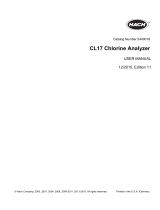Page is loading ...

Chlorine Measurement:
DPD (Colorimetric) vs. Amperometric (Electrode) Method
DPD (Reagent-based method) Amperometric
Technique Colorimetric, Reagent-based Electrochemical, Electrode-based
Description The standard measurement method of
chlorine. This technique uses reagents and
a photometer to measure the amount of free
or total chlorine in a sample.
Designed for process control using two
dissimilar electrodes (anode and cathode)
to measure the change in current based
on a chemical reaction taking place that is
proportional to the amount of chlorine in
the sample.
Interferences Iron causes negative interference at all levels.
Manganese causes positive interference at
all levels.
Dependent on consistent pH, sample
temperature, flow and pressure. Chlorine
concentration cannot fluctuate by more
than ±20%.
Maintenance • Replace reagent monthly
• Replace tubing every 6 months
• Cleaning requirement dependent
on application
• Replace membrane and electrolyte every
3-6 months
• Membrane conditioning and
sensor calibration required after
a membrane change
• Electrode polishing
• Electrode replacement every 6 to
12 months
Calibration • No calibration required. Factory
calibrated (only needs calibrated if
required by a regulatory agency).
• 1-point calibration adjustment based
on a grab sample.
Calibration required once per week due to
electrode drift.
Causes of Fouling Air in sample line, biological growth in
measurement cell and sample turbidity
>100 NTU.
Iron, manganese and high turbidity can
increase calibration and maintenance
requirements.
NSF-61 Certified? No, side stream analyzer. No, side stream analyzer.

Advantages & Disadvantages: The DPD method and amperometric method of measuring chlorine in aqueous
samples each have their own advantages and disadvantages. The amperometric method does not require reagents
like the DPD method but the maintenance schedule is less predictable. The life of electrodes and electrode
membranes will depend on process conditions. The overall maintenance is less when using a DPD analyzer as it
can operate unattended for over 30 days. The amperometric method can cover a larger measurement range than
a DPD analyzer. However, an amperometric electrode cannot measure chlorine accurately if the sample’s pH,
temperature, sample flow, sample pressure and chlorine levels fluctuate more than 20%. The DPD method’s accuracy
on the other hand, is not constrained to these conditions. Furthermore, the DPD method wastes less water than the
amperometric method.
The 3017M is factory calibrated and does not require regular calibrations unless required by the regulatory
agency. This saves time over the amperometric method, which requires weekly calibrations. In addition, unlike the
amperometric analyzer the 3017M is not affected by sample variation. The 3017M operates independent of changes
in pH, temperature, pressure, flow and chlorine.
Advantages Disadvantages
DPD Method
• Easier to install and use
• User calibration not required
• Minimal sample conditioning
• Not affected by changes in pH, chlorine
concentration, temperature, pressure or flow
• Predictable maintenance schedule
• Uses reagents
• Higher maintenance cost
• Not NSF-61 rated
Amperometric Method without pH Compensation
• Reagentless
• Higher measuring range
• Affected by changes in 5+ variables
• Frequent user calibrations required
• Prone to fouling from iron, manganese and
high turbidity
• Unpredictable maintenance, higher cost of
ownership in consumables
• Not NSF-61 rated
• More waste to drain
YSI.com/3017M
YSI, a Xylem brand
1725 Brannum Lane
Yellow Springs, OH 45387
+1.937.767.7241
YSI.com
© 2020 Xylem, Inc. XA00108 0620
GUIDE XA00108
/




